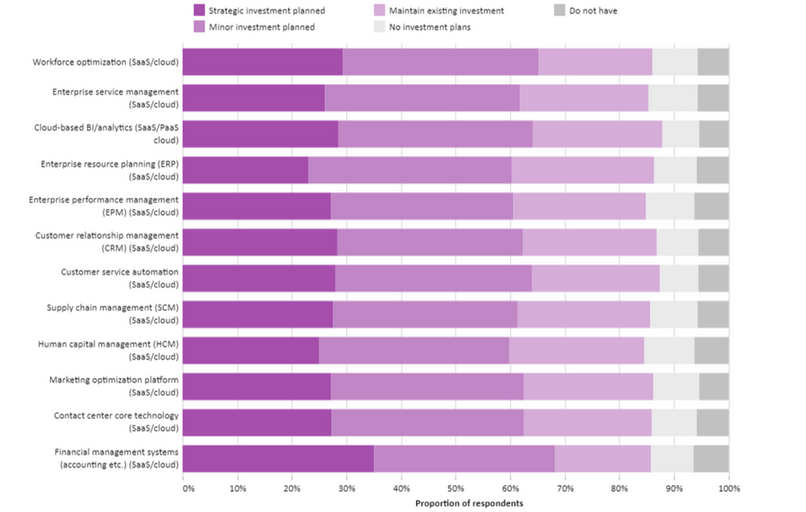By
David Myron
|
Date Published: February 15, 2022 - Last Updated December 05, 2022
|
Comments

Best of ICMI in 2022 - #4:
Nearly two years after contact centers were initially disrupted by COVID-19, the dust is beginning to settle, and long-term IT strategies and investment plans are emerging.
This is evidenced by the recent planned uptick in IT spending. More than half (nearly 60%) of organizations globally are increasing their IT budgets for 2022, according to Omdia’s 2022 IT Enterprise Insights survey. And nearly a quarter (23%) plan to increase their IT budgets 6% or more in 2022—well above the 11.5% reported in 2021.
Many of these investments will focus on three key areas: technological flexibility and scalability, automation and personalization of customer experiences, and the management of a more dispersed and varied workforce.
Contact centers are investing in more flexible and scalable technologies
The pandemic proved that working in an office can present significant business continuity risks, especially if the office is no longer accessible. This is exactly what happened in the first half of 2020 when, in response to the COVID-19 pandemic, state and local governments initiated work-from-home mandates for non-essential workers. Omdia estimates that, at the time, nearly 75% of customer service agents were suddenly forced to work from home.
Contact centers that had distributed operations and remote employees utilizing cloud solutions fared well. However, those that operated in siloed, premises-based locations were significantly disrupted, and some even had to temporarily shut down their support operations. Clearly, the leaders at these locations needed to figure out how to quickly deploy work-from-home environments at scale. Understandably, the fast deployment times, low upfront costs, technological sophistication, and flexibility and scalability of cloud solutions became very appealing to them. And, fortunately, many of these organizations were able to transition to work-from-home environments in only a few days to a week.
Their successful transitions to the cloud sparked a surge of additional interest in cloud technologies. In fact, 54% of organizations said enabling remote work will become more important to them in 2021 and beyond, according to the October 2020 Omdia Future of Work Survey. The survey also revealed that cloud adoption is expected to accelerate into 2022, with 60% of respondents planning their cloud transition and an additional 30% classifying the move from a capital expense to an operating expense.
In fact, according to Omdia’s 2022 IT Enterprise Insights survey, at least 60% of organizations plan to increase their investments in cloud-based contact center technologies. (See below.)

Figure 1: Enterprise applications (SaaS/cloud) investment plans (2022)
This presents an opportunity for organizations to upgrade to a Contact Center as-a-Service (CCaaS) solution. Not only are these technologies location-independent, but they are also updated frequently, enabling contact centers to benefit as the pace of innovation accelerates and becomes a competitive advantage over on-premises technology.
As this happens, however, DevOps teams can become overwhelmed by demands to quickly customize and scale solutions to meet unique and evolving contact center and customer needs. To keep up with demand, these organizations should consider developing a composable architecture, which consists of modular building blocks of functionality that provide flexible, open, and future-ready infrastructure. This enables their DevOps teams to leverage microservices, APIs, and containers to quickly build and scale customized contact center solutions that meet their rapidly evolving objectives.
AI-powered assisted self-service is becoming standard
When the pandemic hit, organizations that did not offer automated, digital channel options for customer self-service faced significant challenges and disruptions to their businesses. Because of this, investments in artificial intelligence (AI) for assisted self-service will become a growing trend in 2022 among contact centers.
AI helps enterprises optimize their workforce and learn about customer interactions to improve their experiences with assisted self-service. Leveraging AI for these purposes will become a growing trend in 2022, as contact centers strive to automate and personalize support with conversational and proactive engagements. AI can supercharge the performance of existing contact center channels and has given rise to new ones, such as chatbots, which help organizations provide a level of support beyond human capacity. Already, 62% of global organizations plan to increase their chatbot investments in 2022, according to the 2022 IT Enterprise Insights survey. In addition to chatbots, AI is empowering additional support technologies such as speech analytics, video, social media monitoring tools, and more.
Contact centers that continue to invest in AI-powered, digital-first engagement and self-service platforms will ultimately find themselves on the leading edge of customer service. When seeking AI developments, however, it’s helpful to remember that data comes first. Enterprises must clean and tag their data before initiating their AI efforts.
Remote work is prompting a dispersed and varied workforce
Because of the pandemic, a new agent workforce is evolving, as well. Contact center managers must staff, manage, and develop in-office, work-at-home, hybrid, and gig employees to ensure key performance indicators are met.
The shift to remote working, a focus on customer satisfaction, and a desire to improve contact center efficiencies will stimulate a higher level of interest in workforce optimization technologies (WOT) from customer engagement managers. As a result, WOT and its subset of applications will experience impressive growth trends in the next few years.
Workforce management software will maintain an impressive compound annual growth rate (CAGR) of 8.3% in the United States, growing from $240 million in 2019 to $357 million in 2024, as it continues to penetrate small to mid-sized contact centers—many of which still use simple Excel worksheets.
Performance management and quality monitoring will grow at CAGRs of 8.6% and 8.2%, respectively, while e-learning and coaching will follow closely with a five-year growth rate average of 7.9%. Call recording, the original WOT, will continue to grow at the 6.0% rate through 2024.
Because cloud technologies enable agents to work remotely, contact center managers are no longer required to hire local employees. Hiring managers can, instead, cast a wider net and attract the most qualified agents. One byproduct of this trend will be the emergence of highly knowledgeable, skilled, and empathetic “super agents,” who will raise the bar in providing exceptional customer service. As these super agents emerge, contact center leaders should put in place the right training, compensation, and career opportunities to retain them.
As these trends continue to unfold, customers, organizations, and agents stand to benefit in significant ways. However, contact center leaders should consider the recommendations presented here to capitalize on these industry developments.
This article includes insights from Omdia’s recently published 2022 Trends to Watch: Contact Center report.